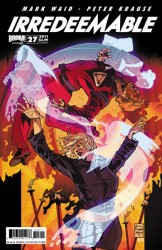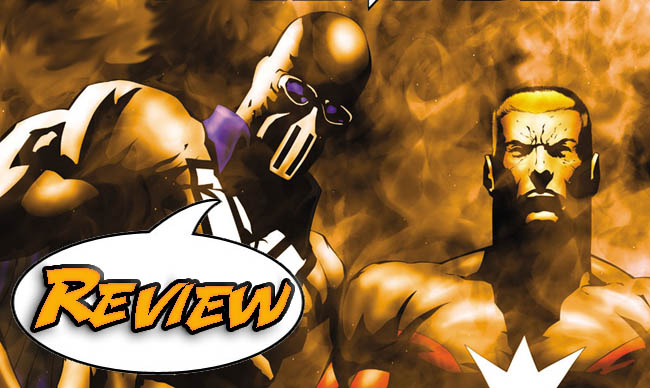Last time we saw the Plutonian, we had to check to see if we had accidentally gone cross-eyed. This month find out why there are two Plutonians, what the unlikely team of Qubit and Modeus will bring about, and what new science fiction explanations Mark Waid will use to flesh out his universe!
 Irredeemable 27
Irredeemable 27
Writer: Mark Waid
Artists: Peter Krause (pgs 1-12), Diego Barreto (pgs 13-22)
Colorist: Zac Atkinson
Letterer: Ed Dukeshire
Editor: Matt Gagnon
Covers: Scott Clark; Drew Johnson (with colors by Mitch Gerards); Scott Clark
Previously in Irredeemable: The Plutonian, known to his former friends as Tony, went berserk and attacked the planet he had formerly sworn to protect, which was pretty bad news as he basically has the power level of golden-age Superman. The Paradigm, his Justice League, managed to capture him and pawn him off on some powerful aliens, the Vespans. Unfortunately they weren’t powerful enough, and they panicked and imprisoned the Plutonian on the high level insane asylum Gehnom, located inside a star. Tony’s not too happy about this, and is making his way out of the prison while gathering up an army of other super-powered criminals. Meanwhile Modeus, the Plutonian’s erstwhile enemy and not-so-secret admirer, has teamed up with Qubit, the technopathic member of the Paradigm, to unite Modeus with Tony, in return for Qubit’s teammate Kaidan, who Modeus has imprisoned using the zombie bodyguard of their former teammate Scylla.
Pseudoscience Done Right
When my friend first introduced me to Irredeemable, I was hooked. While deconstructions of superheroes are all too common these days, Mark Waid managed to create a fresh take on a deconstruction of Superman. While the title grew a bit stale at the point where the Vespans took Tony (“going stale” for this book still being a great title worth reading—merely going from a 4.5 or 5 star story to about a 4 star on a weekly basis), the last few issues seem to be picking the status quo back up to that high quality story. One element I particularly liked was how Waid explained the Plutonian’s powers–he used some elements that have been used before by various people to try to explain golden-age Superman; that the Plutonian is able to manipulate the density of objects, flies by shifting his mass into the atmosphere, and transfers kinetic energy to or from objects to heat or cool them.
As a Physics major and an avid reader of classic science fiction, I really enjoyed these explanations. Mark Waid definitely did some research on his pseudoscience–whereas most comics either don’t bother detailing why their characters can do what they do, or give explanations that hit the extremes of too technical so the reader can’t hope to comprehend them without a PhD (a pitfall that often befell sci-fi Grand Master Arthur C. Clarke) or so far-fetched that they’re closer to fantasy than science (an objection that can be made to the work of another Grand Master of science fiction, Ray Bradbury). Mark Waid’s work reminds me more of the Great Explainer in science fiction, Isaac Asimov; he deftly explains things without requiring more than a cursory knowledge of high school physics terminology.
In this issue, Waid gets off to a good start on having understandable science fiction without wasting his breath explaining what a tachyon is; it’s quite clear that something about the “wiry creep with tachyon hammers for fists” allows him to punch Tony back in time–which led to the second Plutonian we saw at the end of last issue. Anyone who is interested could readily look up the Wikipedia entry on tachyons to discover they’re a hypothetical hyper-photonic particle that, as they travel faster than light, have been used to facilitate time travel in many sci-fi stories. Anyone who isn’t interested doesn’t really lose anything from the story; it’s stated on panel that he hits so hard that he punches people back in time.
The subplot of the mysterious figure who has befriended Tony and helped guide him through the prison is revealed, and the explanation was very satisfactory to me. A shapeshifting psychic symbiotic creature used by the asylum doctors as a sort of anesthetic went rogue and became The Auroran, a hero that embodied the best of the Plutonian; a hero that Tony himself could look up to. The Plutonian doesn’t take kindly to the deception, and punches a hole through his companion, then bursts into the teleportation chamber of the asylum where Qubit and Modeus have been plotting.
The ensuing scene is cleverly done, but I didn’t catch all the nuances of the time travel involved on my first read-through. On the second read-through of the scene I understood what had happened, but still questioned the necessity of its complexity. On my third, I appreciated the craftsmanship a bit more, but I still think it could have been handled better; I have a feeling many people not as time-travel savvy may be lost with how the issue’s end transpired, but it isn’t necessary to know the how in order to appreciate the gravity of the situation; some high powered villains have just made it to Earth, and the heroes are in trouble. This final scene knocks the story down from a 5 out of 5 stars to a 4.5. Time travel is a dangerous route to take, and needs to be handled with much care for the reader, but overall Waid knows what he’s doing.
The Art:
I haven’t really cared much for either Peter Krause or Diego Barreto’s art on Irredeemable, especially compared to the clean and polished look of Marcio Takara’s work on its sister book, Incorruptible. At C2E2 I had an opportunity to ask Kevin Maguire about what he felt the most important thing to keep in mind when drawing was–he told me it is of utmost importance to remember that you are drawing figures in action, not action figures. Most of Diego Barreto’s art looks as if his characters are merely posed action figures, and when the events of the panel have transpired they will be stuck with that expression in that pose for eternity. I can’t find too much to specifically complain about with Peter Krause’s art, other than that I don’t particularly care for the facial expressions on his characters, but there’s something intangible about his art that just doesn’t quite work for me. It’s never enough to distract me from the story (unlike Barreto’s art), but it also doesn’t add to the story like Takara’s does for Incorruptible. I give the art a 3 out of 5 stars.
The Verdict:
If you have been following Irredeemable (as you should be), then issue 27 is a must read. Waid has worked through his mid-series slump, and things are picking up to be back on par with the excitement of the early issues. I’m very intrigued by where he’ll go with it, and am definitely on board for this story, whereas 5 or so issues ago I had been wavering. Overall a solid 4 out of 5 stars for Irredeemable 27.





2 Comments
The book keeps getting better with each issue. Great review for a great issue.
P.S. The explanations of Tony’s powers? Fan-friggin-tastic!
Great review. I might cave and go buy a new comic for the first time in almost a year.
I do like the idea of a guy who can punch you so hard, he can punch you into last week.